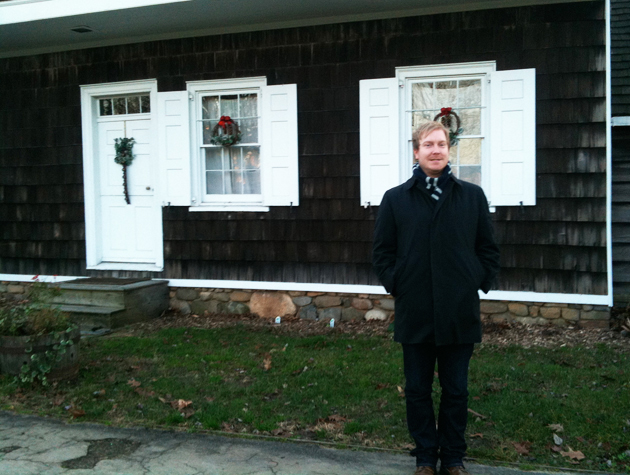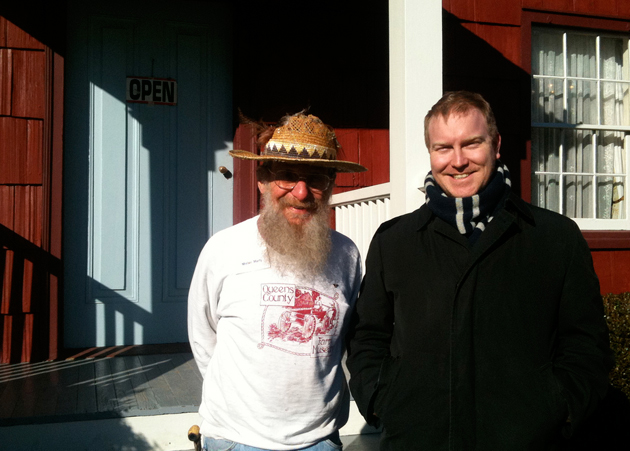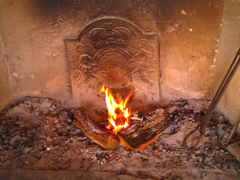When I was in the fifth grade my class took a trip to a historical farm museum in Tifton, Ga., called Agrirama, a fully functioning re-creation of a Reconstruction-era sugar cane farm. There were historical re-enactors who split the class on gender lines, boys going to work in the barn and fields, girls taken to prepare the meals and take care of the homestead. We were there for a full school day. I shoveled shit (literally), fed a sugar cane press, and was remonstrated for the inexperience I showed in doing both. All of this was historically sound, because any able-bodied boy was expected to contribute in like fashion. It sucked.
Luckily my experience with farms wasn’t exclusively colored by that foul childhood experience. My dad’s father was a cattleman. He grew up in Texas, then moved to Kansas. After he and hundreds, maybe thousands of other cattlemen were replaced by factory farms, both here and outside the country, he went to work for the USDA as a meat inspector until retirement. He kept his farm, however, and raised horses and cattle as a hobby for the rest of his days. My sister and our cousins played a lot on his farm growing up. It was there that I rode my first horse, went fishing in ponds, played hide and seek in the barn hayloft, and went hunting the only time in my life. What I learned was that farms are great to play on, but the reality of sustaining oneself via the life agricultural is hard and relatively joyless, and it must have been all the more so back in the day.
Next up on my excursions to historic New York were two farmhouses, one now defunct in the sense that it no longer produces. Due to my class trip to Agrirama, I admit I was hesitant to visit the working farm, the Queens County Farm Museum, for fear I’d be put to work. The tour description said nothing of the sort, but I am moderately paranoid. Having visited the homes of a few of the wealthy landed gentry (Hamilton Grange, the Van Cortlandt House Museum, etc.), I expected these farmhouse visits to make the toil of the proletariat uncomfortably accessible. While those expectations were met, to a degree, I also realize I harbor some capital-R Romantic notions concerning the pastoral lives of the working poor, fed equally by 19th-century poets, painters, and essayists, and my own nostalgia for my childhood visits to Kansas.
In mid-December I visited the Wyckoff Farmhouse Museum, which is in the neighborhood of Canarsie in eastern Brooklyn. Built in 1652 by Dutch farmer Pieter Claesen Wyckoff (a familiar last name to modern residents of Brooklyn), the farmhouse is the oldest surviving wooden structure as built by European settlers in the Americas. The farmhouse was hosting a candlelight tour focused on lighting technology, appropriately, and some of the architectural features of the farmhouse. I had recently met official clean person Jolie Kerr, who had expressed interest in coming along for the ride to one of the historic sites on my list. She helpfully served as an impromptu photographer for the trip, but mostly I think she was interested in scoring some old-fashioned cleaning tips, and more power to her.
The website for the farmhouse said that the tour “starts PROMPTLY at 4:30 p.m.,” so we showed up a half-hour early, at which point the house—nestled into a scrubby green lot in the single-block M. Fidler-Wyckoff House Park, inside brick-and-asphalted Canarsie—was still locked. After waiting for only a minute or so, a woman emerged from a trailer situated perpendicular to the farmhouse. As she approached, followed cautiously by a mostly black-and-white cat, the woman introduced herself as Lucy and asked if we were there for the tour. She told us we were the only ones not to cancel that evening, and that she wouldn’t be ready until 4:30. Lucy recommended we hit the McD’s a few buildings over to get a hot chocolate while we waited.
Jolie and I decided to kill the half hour at the next-door Footprints Café, the self-proclaimed “Home of the Rasta Pasta.” A couple of drinks later, we returned in time for the tour, the beginning of which had been scheduled to coincide with the setting of the sun. By now another adventurous tourist named Dwaine had joined the tour. We talked briefly, and he explained that he grew up in Canarsie, but now works in the Bronx as a horticulturist/beekeeper. I don’t want to oversell it, but he seemed really cool. (I got his card, which is why I know how to spell his name right.) Dwaine was biking in his old neighborhood that night after visiting family, and passed by the farmhouse when his curiosity took over. He just thought he’d pop in and see what was going on.

Lucy led us into the farmhouse, where she’d lit a single candle in its silver stick on a small table in the center of four chairs. We entered, ducking our heads below the lintel. Unlike many sites I’ve been to in this city, electric lighting had not been installed in the Wyckoff farmhouse. Dwaine, Jolie, and I sat in a semi-circle with Lucy opposite us, the candlelight barely illuminating our faces. On the same small table with the lit candle was an assortment of unlit candles, lanterns, candle-making tools, reeds, etc. The cat we’d seen earlier wandered in. Lucy asked if we minded or were allergic, because if she tried to put Silvia in the other room, she explained, she’d only cry at us throughout the tour. We were totally OK with it.
The experience reminded me of the hurricane parties we had growing up in Florida. I mostly grew up with my maternal grandparents, and my grandmother was the declarer of all parties in the house. When our power went out due to a passing hurricane (this probably happened about a dozen times during my childhood), she’d have already assembled an oil lamp, a deck of cards, and an assortment of candy at the dining table. We’d spend the evenings, sometimes the whole night, me and my sister, sitting around the table with my mom and our grandparents, playing cards, singing songs, and smacking our little kid lips with licorice and chocolate, all of us glowing by the light of the lamp. Save for a handful of emergency flashlights—it’s not as if my grandfather, the Eagle Scout, was ever unprepared—the oil lamp at the table’s center was our only light.
It wasn’t precisely the same feeling of filial intimacy that I felt there at the Wyckoff farmhouse that night, much less the childlike wonder, but it was oddly comforting in much the same way. Our small group was assembled as a stand-in for the average colonial farm family that littered the boroughs hundreds of years before.
After briefly running through the history of the farmhouse itself, Lucy got into lighting technology by asking what the first source of light people used was. Dwaine said something like whale oil; I said “just oil,” trying to be clever. Lucy said, “The sun!” in that duh kind of voice. She got us on questions like that a few times, actually. So yeah, people back then used sunlight, and painted all the walls in their homes white to ensure favorable reflectivity, and they always built their kitchens, the most productive rooms in the house, facing south to get the most sunlight. They also used to believe that night air was bad for you, like cursed or something, and they’d make sure to close their shutters at night to stave off the foul night air, even if it was stifling hot in the summer. What dummies.
Holding us, her pupils, in playful, almost schoolmarmish reproach, Lucy continued to be thoroughly engaging as we passed through the other rooms, added to the house in stages over two centuries. She also proceeded along the thread of advances in lighting, candles, barn lamps designed to deflect wind, and the tinsmiths who made them. Jolie asked for the occasional cleaning tip according to colonial fashion, and Dwaine asked about the old farm’s produce and agricultural concerns of the day. I felt like the only one without good questions. Finally, Lucy brought us up to the widespread use of oil lamps, followed by the advent of electricity, which remained prohibitively expensive for use in most homes well into the 20th century.
From there, Lucy led us into the gift shop to settle up the bill. I hate playing favorites, but Lucy might have been the best tour guide I’ve had yet. I asked how she got involved with the Wyckoff farmhouse. Lucy said she’d worked in costume and set design all over the city for years, and specifically for one of the Shakespeare companies. There was an event at the Wyckoff house in need of period costuming, and she came out to help. She claims it wasn’t long before she fell in love with the place, and she’s been there over a decade since.
About a month later I visited the Queens County Farm Museum, which is technically in Floral Park, which I don’t know if it’s actually still Queens out there. It’s barely shy of being Long Island proper at that point. Fellow TMNer Pitchaya Sudbanthad came along for the ride, after we agreed to consume adventuresome foods in Flushing on the way back. From where we live all the way across Brooklyn, we decided to take the LIRR out to the site on one of the two coldest days of the year so far, but at least it was clear and sunny.
Once we got to the LIRR station at Floral Park, we still had to take a car ride of about 15 minutes over to the farm. Upon our arrival, we strolled right up to the main farmhouse as another tour seemed to be letting out. A bright-eyed, elderly gentleman introduced himself as Marty, and asked if we’d like to take the tour as well. He led us into the house and gestured for us to wait for him for a moment in the kitchen. After a few minutes he joined us and launched into a rapid fire Q-and-A with Pitchaya and me, the only people on that particular tour (which was also totally free, by the way).

He asked, because he’s interested to learn, why we came to the farm on that day. I told him about the series I was writing, and I asked about his background. Marty, prodigiously bearded and wearing a straw hat with several flamboyantly protruding quail feathers, is a historical re-enactor, or as he put it, he does “living history.” His milieu therein is “mountain man,” and after talking to him briefly, we realized we’d been to the same event at St. Paul’s church in the Bronx back in October. I apologized for not speaking with him that day. He did look familiar, even though on that day at the Queens County Farm he was not dressed head-to-toe in buckskin.
Marty has been doing living history since the ’70s, and has participated in events involving thousands of re-enactors, who he told us will happily dress down any historical inaccuracies they find in your costume, down to the stitching. As part of a group, Marty has also traversed the whole of Lewis and Clark’s route from St. Louis to the Pacific, though he said they did take a bus. He’s currently working on a book about the historic forts of America. I’m very happy to have made his acquaintance.
He launched into the tour proper by explaining, again in rapid-fire succession, how the kitchen of a colonial home would have functioned. Marty showed us Dutch ovens, and S-hooks, and reflector ovens galore. He showed us a flint and steel, and explained the process of starting a fire with it, something he has years of experience handling as a mountain man. He had dolls dressed up to represent the clothing styles of men and women at the time. The funniest thing was how he kept exhorting us to find these materials online. “You can go to your computer and order a flint and steel of your own, and they’ll teach you how to do it.” “You can order a cow horn off your computer, and make a powder horn or a drinking cup out of it.” “You can order kits for all these old toys off your computer.” He seemed well up on his online shopping for such an ardent anachronist, is what I’m saying.
He gives the same tour nearly every weekday to elementary classes, so perhaps he’s used to explaining things more quickly in an effort to hold much younger visitors’ attentions. I’ll admit I sometimes need things explained in reference to computers now too. Anyway, once he wrapped up in the kitchen, he led us into the other rooms while he explained that the farmhouse was built by the Adriance family. The land on which the farmhouse sits was sold to Elbert Adriance in 1697, making its 47 acres the oldest continuously active farm in New York state, and possibly the country. Elbert’s grandson Jacob built the three-room farmhouse (lavish by colonial standards) in 1772. Not the oldest standing building in New York, but pretty damn old. The museum website has an extensive history of how often the farm changed hands, and by whose hands it changed, so I won’t go much further into that except to say that it was put on the National Register of Historic Places in 1975, the same year it became a museum.
We passed through the rooms as Marty fired off the history of the additions to each. He made sure to point out the elegant little chamber pot stand, which I believe Pitchaya and I perhaps displayed as much amusement over as the schoolchildren Marty’s used to guiding. Both he and Lucy from the Wyckoff house mentioned having to keep the kids from climbing all over the furniture and touching all of the antiques, though not the chamber pot, I’m guessing. Considering my own school trip to Agrirama at 10 years old, I scoffed inwardly at the city’s school children today, only having to hear about the difficult conditions for children of the 18th century. They don’t even force kids to shovel horse poop to learn about the old days anymore. What is our world coming to? I do remember, however, being scornfully reprimanded by the head matron at Agrirama, for sitting on the bed in the farmhouse after lunch. A few of us had. She asked, full of shock, “Would you just sit on someone else’s bed if you went over to play at their house?” We were all, “Uh, yeah.” Because that’s exactly what we did. Kids have their own kingdom.
Marty eventually brought us back to the entrance, where another couple was waiting outside the door for the same tour. He was also a great guide, and very friendly. We thanked him, and while he let the other group in, we chatted a few more minutes about advances in military armaments and the rules of engagement over the centuries, which are issues of some concern for many living historians. It turns out that Marty had also never met anyone from Thailand. Lots of new experiences that day. I highly recommend taking the tour if you can ever bring yourself to make the schlep.

After the tour, Pitchaya and I wandered the grounds of what is very much an active farm. First we went over to call to the sheep, who looked just dandy in their winter woolen coats. They didn’t seem to be irked in the slightest that it was below freezing out. The roosters and chickens nearby seemed likewise indifferent to our shivering. We passed on, spotting geese and heifers. Marty had made a point of discerning between heifers, which have never given birth, and cows, which have. Pitchaya and I dawdled at the goat pen, where one goat allowed Pitchaya to pet it before trying to eat his satchel. The farm is also home to a pair of alpacas, which have goofy little spiky pompadours, if you’ve never seen them. Pitchaya pointed out, somewhat favorably, that they look sort of like Liza Minelli. We made it as far as the vineyard before turning back. There’s a gift shop across from the Adriance house, which was closed for lunch, but sells the produce of the farm, including wine, preserves, eggs, and the like. There also seems to be a greenhouse attached, but we couldn’t get in and decided not to wait in the cold for the shopkeeper to return.
After a bus ride back to the nearest F station, Pitchaya and I made a further excursion into Flushing, where we ate indecent amounts of pan-Asian delectables at the New World Food Court. I ate fried octopus balls, duck noodles, and pork kidney. The noodles were handmade, a fact that stood out considering the amount of agricultural product brought in from around the globe just to feed that one food court. And there are places just like it everywhere. Agrirama was self-sustainable, as is the Queens County Farm Museum. Many people have written about the exorbitant amount of infrastructure and energy needed to sustain the rest of the world, and the likelihood that we won’t be able to maintain it. From a self-interested standpoint, I really don’t want to work on a farm, so we might need to do things differently.
